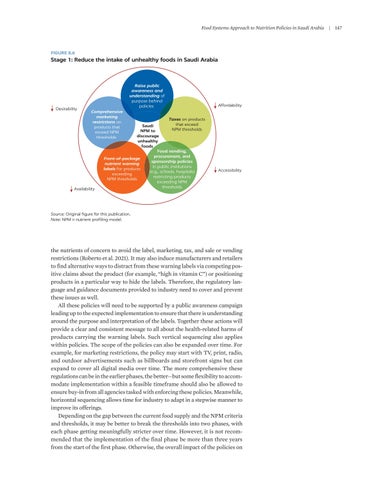Food Systems Approach to Nutrition Policies in Saudi Arabia
FIGURE 8.6
Stage 1: Reduce the intake of unhealthy foods in Saudi Arabia
Desirability
Raise public awareness and understanding of purpose behind policies Comprehensive marketing restrictions on products that exceed NPM thresholds
Availability
Affordability Taxes on products
that exceed Saudi NPM thresholds NPM to discourage unhealthy foods Food vending, procurement, and Front-of-package sponsorship policies nutrient warning in public institutions labels for products (e.g., schools, hospitals) exceeding restricting products NPM thresholds exceeding NPM thresholds
Accessibility
Source: Original figure for this publication. Note: NPM = nutrient profiling model.
the nutrients of concern to avoid the label, marketing, tax, and sale or vending restrictions (Roberto et al. 2021). It may also induce manufacturers and retailers to find alternative ways to distract from these warning labels via competing positive claims about the product (for example, “high in vitamin C”) or positioning products in a particular way to hide the labels. Therefore, the regulatory language and guidance documents provided to industry need to cover and prevent these issues as well. All these policies will need to be supported by a public awareness campaign leading up to the expected implementation to ensure that there is understanding around the purpose and interpretation of the labels. Together these actions will provide a clear and consistent message to all about the health-related harms of products carrying the warning labels. Such vertical sequencing also applies within policies. The scope of the policies can also be expanded over time. For example, for marketing restrictions, the policy may start with TV, print, radio, and outdoor advertisements such as billboards and storefront signs but can expand to cover all digital media over time. The more comprehensive these regulations can be in the earlier phases, the better—but some flexibility to accommodate implementation within a feasible timeframe should also be allowed to ensure buy-in from all agencies tasked with enforcing these policies. Meanwhile, horizontal sequencing allows time for industry to adapt in a stepwise manner to improve its offerings. Depending on the gap between the current food supply and the NPM criteria and thresholds, it may be better to break the thresholds into two phases, with each phase getting meaningfully stricter over time. However, it is not recommended that the implementation of the final phase be more than three years from the start of the first phase. Otherwise, the overall impact of the policies on
|
147






